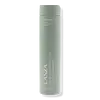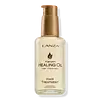What's inside
What's inside
 Key Ingredients
Key Ingredients

 Benefits
Benefits

 Concerns
Concerns

 Ingredients Side-by-side
Ingredients Side-by-side

Water
Skin ConditioningSodium C14-16 Olefin Sulfonate
CleansingSodium Lauroyl Methyl Isethionate
CleansingCocamidopropyl Betaine
CleansingSodium Lauroyl Lactylate
EmulsifyingHydrolyzed Pea Protein
EmollientHydrolyzed Vegetable Protein
Skin ConditioningMelia Azadirachta Seed Oil
EmollientEntada Phaseoloides Bark/Seed Extract
Skin ConditioningCamellia Sinensis Leaf Extract
AntimicrobialDimethiconol Cysteine
Sodium Hyaluronate
HumectantLimnanthes Alba Seed Oil
Skin ConditioningSodium PCA
HumectantMagnesium PCA
HumectantZinc PCA
HumectantManganese PCA
HumectantSqualane
EmollientEthylhexyl Olivate
Skin ConditioningAscorbic Acid
AntioxidantSorbic Acid
PreservativeChlorphenesin
AntimicrobialBenzoic Acid
MaskingGlycerin
HumectantPentaerythrityl Tetra-Di-T-Butyl Hydroxyhydrocinnamate
AntioxidantGlycol Distearate
EmollientEthylhexylglycerin
Skin ConditioningSilicone Quaternium-3
Trideceth-12
EmulsifyingGuar Hydroxypropyltrimonium Chloride
Skin ConditioningTris(Tetramethylhydroxypiperidinol)Citrate
StabilisingPEG-150 Distearate
EmulsifyingCitric Acid
BufferingSodium Hydroxide
BufferingSodium Chloride
MaskingAlcohol
AntimicrobialPhenoxyethanol
PreservativeCaprylyl Glycol
EmollientPotassium Sorbate
PreservativeSodium Benzoate
MaskingBenzisothiazolinone
AntimicrobialParfum
MaskingHydroxycitronellal
PerfumingLimonene
PerfumingLinalool
PerfumingWater, Sodium C14-16 Olefin Sulfonate, Sodium Lauroyl Methyl Isethionate, Cocamidopropyl Betaine, Sodium Lauroyl Lactylate, Hydrolyzed Pea Protein, Hydrolyzed Vegetable Protein, Melia Azadirachta Seed Oil, Entada Phaseoloides Bark/Seed Extract, Camellia Sinensis Leaf Extract, Dimethiconol Cysteine, Sodium Hyaluronate, Limnanthes Alba Seed Oil, Sodium PCA, Magnesium PCA, Zinc PCA, Manganese PCA, Squalane, Ethylhexyl Olivate, Ascorbic Acid, Sorbic Acid, Chlorphenesin, Benzoic Acid, Glycerin, Pentaerythrityl Tetra-Di-T-Butyl Hydroxyhydrocinnamate, Glycol Distearate, Ethylhexylglycerin, Silicone Quaternium-3, Trideceth-12, Guar Hydroxypropyltrimonium Chloride, Tris(Tetramethylhydroxypiperidinol)Citrate, PEG-150 Distearate, Citric Acid, Sodium Hydroxide, Sodium Chloride, Alcohol, Phenoxyethanol, Caprylyl Glycol, Potassium Sorbate, Sodium Benzoate, Benzisothiazolinone, Parfum, Hydroxycitronellal, Limonene, Linalool
Cyclopentasiloxane
EmollientDimethicone
EmollientCaprylyl Methicone
Skin ConditioningCrambe Abyssinica Seed Oil
Skin ConditioningOrbignya Speciosa Kernel Oil
EmollientAstrocaryum Murumuru Seed Butter
EmollientKeratin Amino Acids
Skin ConditioningEuterpe Oleracea Fruit Oil
Skin ConditioningCoffea Arabica Seed Oil
MaskingCereus Grandiflorus Flower Extract
Skin ConditioningDimethiconol Meadowfoamate
EmollientSodium PCA
HumectantMagnesium PCA
HumectantZinc PCA
HumectantManganese PCA
HumectantIsopropyl Palmitate
EmollientTrimethylsiloxyamodimethicone
Benzotriazolyl Dodecyl P-Cresol
UV AbsorberPolysilicone-15
UV FilterPropylene Glycol
HumectantWater
Skin ConditioningParfum
MaskingCinnamyl Alcohol
PerfumingAlpha-Isomethyl Ionone
PerfumingCI 26100
Cosmetic ColorantCI 47000
Cosmetic ColorantCyclopentasiloxane, Dimethicone, Caprylyl Methicone, Crambe Abyssinica Seed Oil, Orbignya Speciosa Kernel Oil, Astrocaryum Murumuru Seed Butter, Keratin Amino Acids, Euterpe Oleracea Fruit Oil, Coffea Arabica Seed Oil, Cereus Grandiflorus Flower Extract, Dimethiconol Meadowfoamate, Sodium PCA, Magnesium PCA, Zinc PCA, Manganese PCA, Isopropyl Palmitate, Trimethylsiloxyamodimethicone, Benzotriazolyl Dodecyl P-Cresol, Polysilicone-15, Propylene Glycol, Water, Parfum, Cinnamyl Alcohol, Alpha-Isomethyl Ionone, CI 26100, CI 47000
Alternatives
Ingredients Explained
These ingredients are found in both products.
Ingredients higher up in an ingredient list are typically present in a larger amount.
This ingredient is the magnesium salt of PCA (Pyrrolidone Carboxylic Acid). It is a great skin hydrator for the top layers of skin.
PCA is a natural humectant, meaning it draws water from the air to your outer layer of skin.
One study found magnesium ions improved skin hydration in the outer layer of skin, or the stratum corneum. However, it did not improve TEWL, or the transepidermal water loss. The TEWL is an indicator of how healthy your skin barrier function is. This study primarily looked at healthy skin with intact skin barrier.
Learn more about Magnesium PCAWe don't have a description for Manganese PCA yet.
Parfum is a catch-all term for an ingredient or more that is used to give a scent to products.
Also called "fragrance", this ingredient can be a blend of hundreds of chemicals or plant oils. This means every product with "fragrance" or "parfum" in the ingredients list is a different mixture.
For instance, Habanolide is a proprietary trade name for a specific aroma chemical. When used as a fragrance ingredient in cosmetics, most aroma chemicals fall under the broad labeling category of “FRAGRANCE” or “PARFUM” according to EU and US regulations.
The term 'parfum' or 'fragrance' is not regulated in many countries. In many cases, it is up to the brand to define this term.
For instance, many brands choose to label themselves as "fragrance-free" because they are not using synthetic fragrances. However, their products may still contain ingredients such as essential oils that are considered a fragrance by INCI standards.
One example is Calendula flower extract. Calendula is an essential oil that still imparts a scent or 'fragrance'.
Depending on the blend, the ingredients in the mixture can cause allergies and sensitivities on the skin. Some ingredients that are known EU allergens include linalool and citronellol.
Parfum can also be used to mask or cover an unpleasant scent.
The bottom line is: not all fragrances/parfum/ingredients are created equally. If you are worried about fragrances, we recommend taking a closer look at an ingredient. And of course, we always recommend speaking with a professional.
Learn more about ParfumSodium PCA is the sodium salt of pyroglutamic acid. It is naturally occurring in our skin's natural moisturizing factors where it works to maintain hydration.
The PCA stands for pyrrolidone carboxylic acid, a natural amino acid derivative.
This ingredient has skin conditioning, anti-inflammatory, and humectant properties. Humectants help hydrate your skin by drawing moisture from the air. This helps keep your skin moisturized.
Learn more about Sodium PCAWater. It's the most common cosmetic ingredient of all. You'll usually see it at the top of ingredient lists, meaning that it makes up the largest part of the product.
So why is it so popular? Water most often acts as a solvent - this means that it helps dissolve other ingredients into the formulation.
You'll also recognize water as that liquid we all need to stay alive. If you see this, drink a glass of water. Stay hydrated!
Learn more about WaterZinc PCA (or "zinc salt") differs slightly from zinc itself. PCA stands for pyrrolidone carboxylic acid. However, Zinc PCA comes from zinc.
It can help reduce redness, regulate sebum, and promote the general healing process of the skin.
Zinc PCA tends to be especially useful for those with oily, acne-prone skin. It's certainly an ingredient worth trying out!
Learn more about Zinc PCA